Encyclopedia of Tree Guards
Location: Goose paddock, with mining pit and seasonal lake
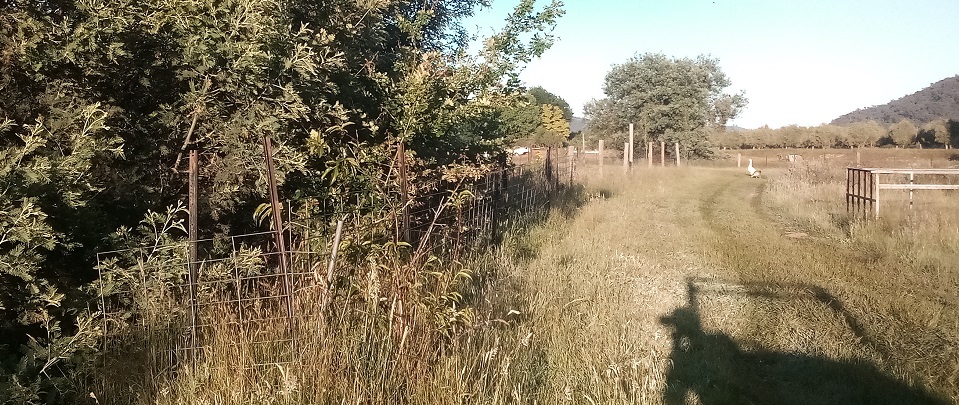
Here you are seeing trees planted along the edge of a (mining pit) drop off wall to the left. A long sheep mesh fence is a metre from the "precipice", with trees planted in that space. End points stop livestock getting in. At least one athletic sheep has climbed up the wall face from below to get into this area! Overall this is quite successful, but has been there for a long time as the trees have been very slow to grow, possibly because of the proximity to the vertical wall on the pit.
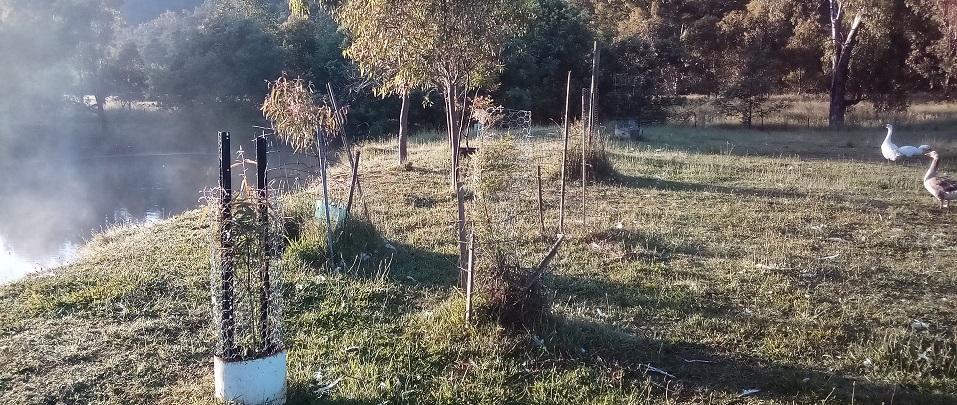
Around the corner from the long edge-row of trees are individual tree guards. The long term aim it to grow shadow trees above the lake in the mining pit to slow its summer dryout. Again, these trees have been very slow growing. You can see the higher gums have had the tree guards removed. The lower branches that the sheep can reach have been cropped, but higher up the trees are bushy. Our sheep don't chew gum trunks, just leaves and small branches. That is, the tree guard is only needed until the tree is a few years old. .
Mostly sheep
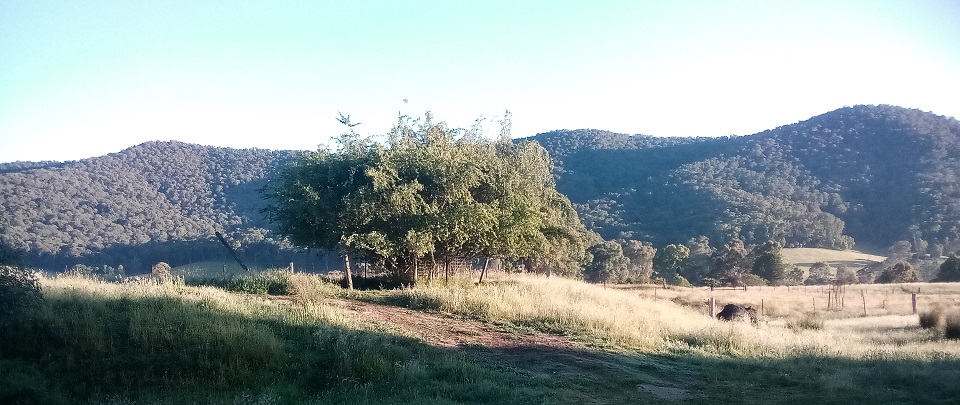
This has been very successful. A meshed fence encloses a 6 x 3 metre rectangle. Inside are tagasaste trees. The sheep crop whatever they can reach, but cannot get to the trunks. The height of the mesh fence means they end up creating a wide rain shelter area, and there is competition for the best spots under the tagasaste hedge. Sheep will chew tagasaste trunks and kill the tree, so this needs to be a permanent fence.
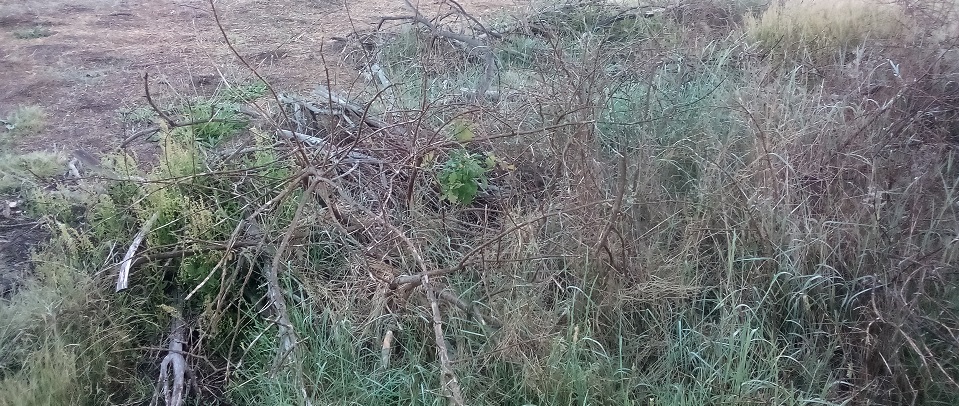
Feral tree guard. Olive prunings are piled around a sapling, which is visible in this pic in the centre of this mess! Livestock avoid the sharp, dried prunings and the tree is untouched. We prune every year and every so often top up the pile, as it collapses as it degrades. But this has been here for more than three years. (We should have more trees in that space, you would think, but the location is very poor. Previous plantings have failed to take in the mostly rock mining spoil. These trees are grown on the spot from seed. Takes longer but they seem to do better than transplanted saplings which have a high failure rate.)
Paddocks
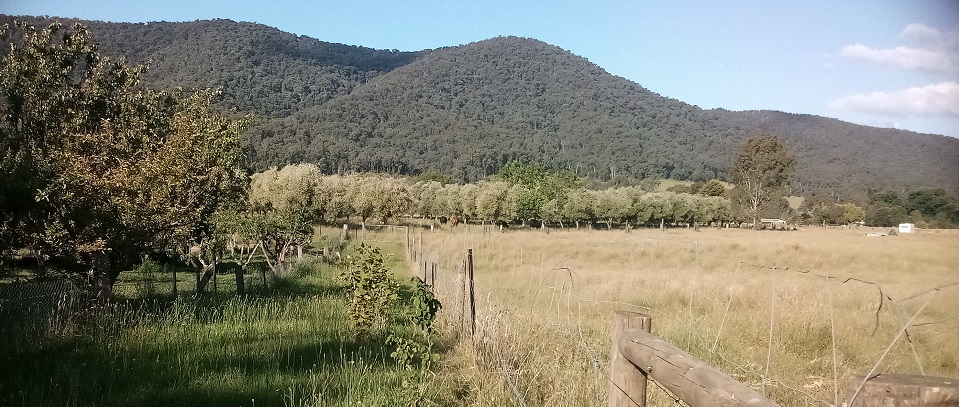
To the left is an established fruit orchard. This hazelnut laneway is an extension of that orchard. Laneway plantings have been used successfully by us and previous owners to keep the trees free of livestock damage. A lot of work, and significant space and resources needed to implement, but generally successful.
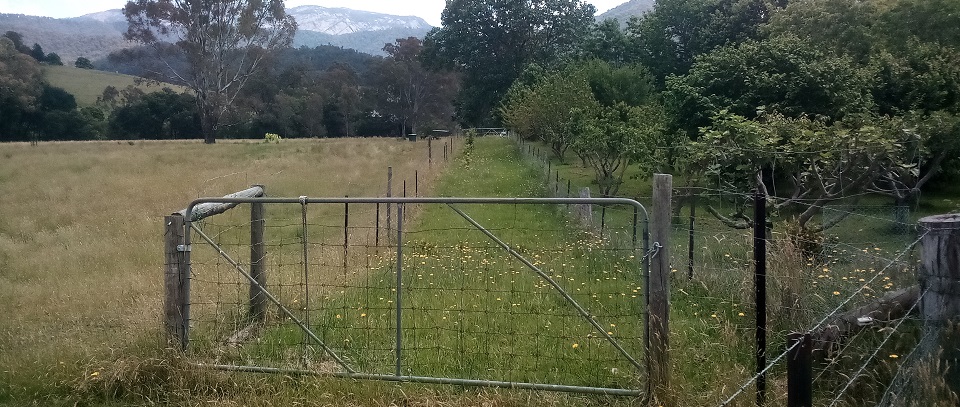
Same hazelnut laneway from the other end. Still room for more trees!
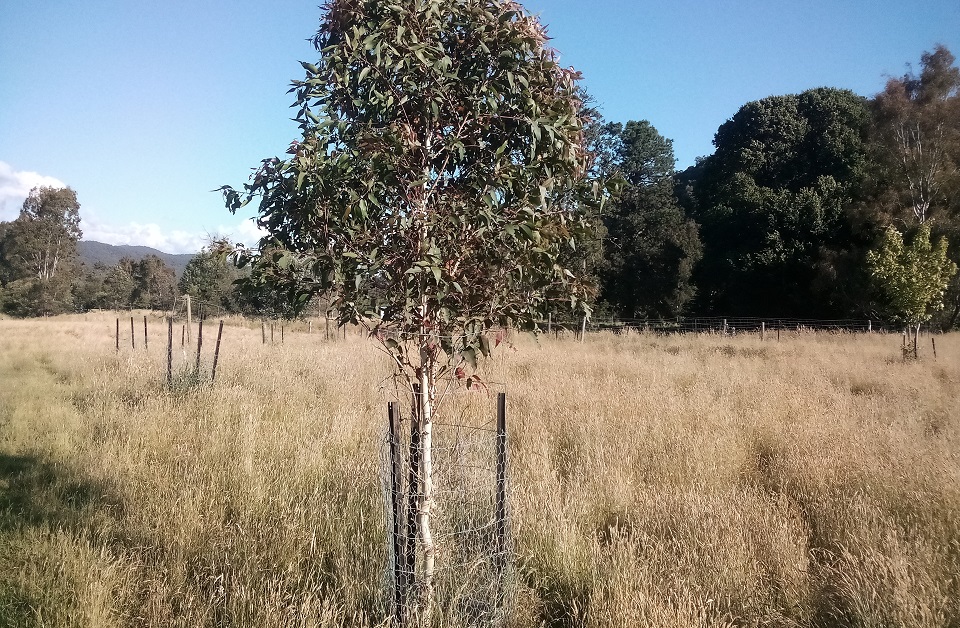
For us, a 120cm guard is enough. Once the tree is above that height it can grow without being cropped by sheep, and it really takes off. (Cattle and deer would be able to access this, of course.) This is an example of the triangular guard. Each side is 60 cm, a star picket or pine post at each corner. Sides longer than 60 cm get crushed in by the sheep and the sapling within is damaged. Sides shorter than 60 cm don't leave much space inside for growth and the tree gets shredded on wire. We cut a 2m length of chicken wire and overlap it around the triangle. An improvement would be a simple way of unwrapping the wire for weeding within the guard.
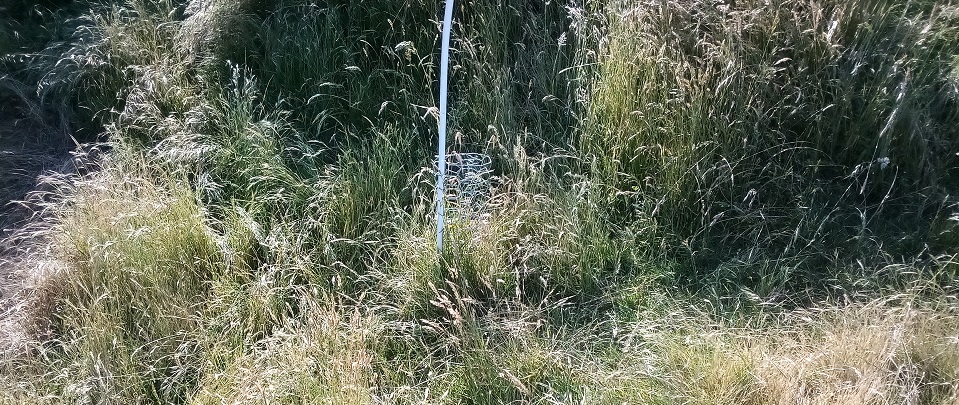
For low value seedlings or with a high risk of failure, we use a quick guard. Its a small tube of heavy gauge chicken wire attached to a single spike. In this case its an alloy tent pole segment. This sapling is a river red gum. In this spot we have tried a few trees that have failed. The redgum is from seed and we have quite a few. If we get to the stage that the redgum grows to the top of the wire tube we will replace the guard with something bigger. The thinking is that a "proper" three pointed/star picket guard is a lot of work, and we should only apply that to something that will succeed. I can cut dozens of these tubes for saplings from the wire needed for a proper guard. We use the same strategy to plant tagasaste seedlings in a mining spoil pile. The tube is strong enough to withstand interest from sheep, although they will crop anything that sticks outside the tube.
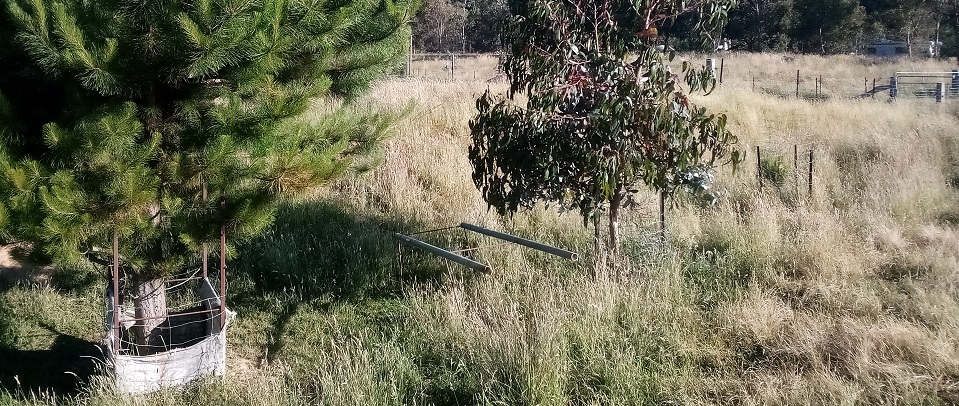
Not a great picture. What we are looking at are welded steel rebar/round steel frames. There is one lying on the ground and one around the pine tree. When we moved in these were sheltering cold sensitive avocado trees, and blankets were wrapped around them (every winter's night!) for a few years. When the trees got big enough the steel frames were then re-used to provide heavy-duty shelter for new trees. They are great but the trees have grown so big I will have to cut the frames off to re-use them.
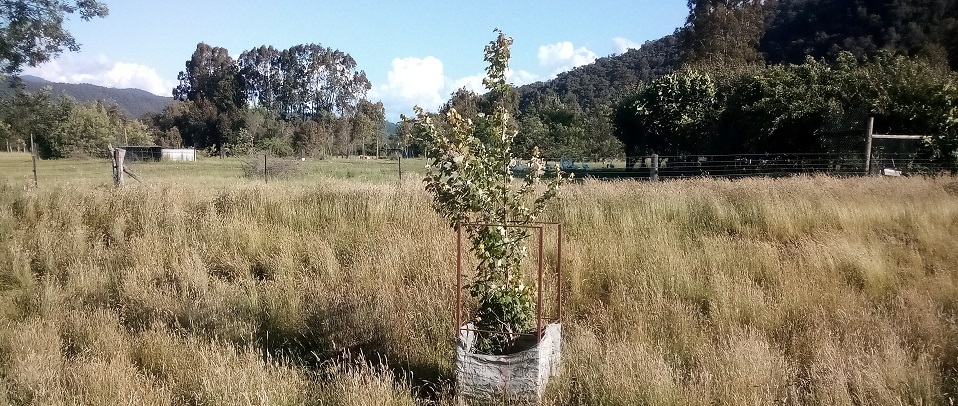
Another welded square steel frame.
Note in the background to the right is a concentrated tree "reserve" in the goose paddock. The trees were overplamted inside a compound to provide shelter from predator hawks/eagles. Most of the trees are fruit bearing, so they drop fruit for the geese. Within the compound each tree is within a round 20cm diameter tree guard to protect them as they were growing....geese will. shred small trees.
Deer and Cattle tree guards
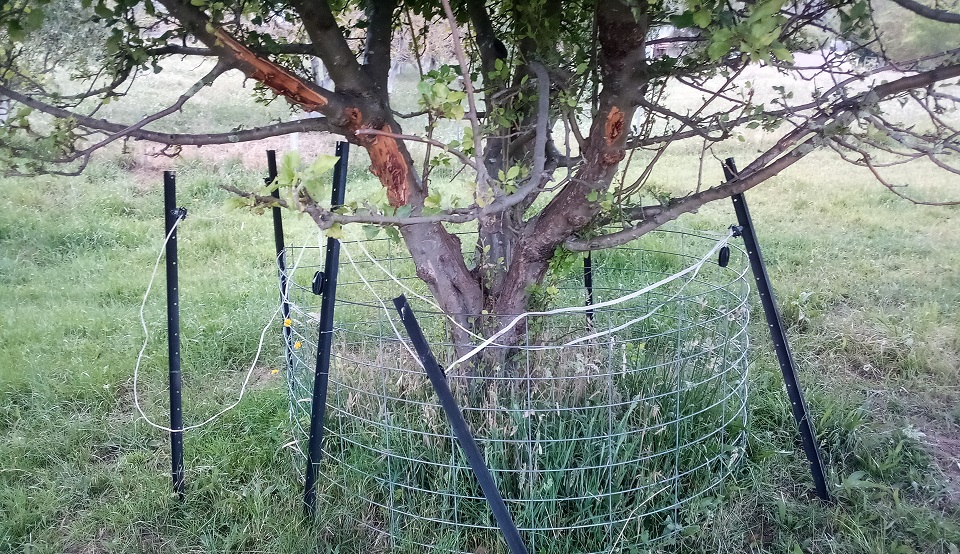
This was set up to protect this mature apple tree from deer. We have hardly any deer problems. Although we are along the river with plenty of cover, they don't seem to be able to get through the shooters on the properties between us and the bridge. On the other side is kilometers of scrub fronting the river on the massive commercial farm, which runs to Myrtleford. But in the seven years we have been here I have only seen one deer in that farm, and have almost never seen deer browsing damage to our olive trees.
The apple tree is right up the front of the property, close to the main road. I think the deer are coming in off the road.
So, what was set up was a electrified round, with a temporary solar energizer attached. We had no damage for six months so I removed the energizer. The deer came back, crushed the fence and chewed the tree. An expensive long term option, counting the cost of star pickets and energizer. But if I don't re-activate it, they will kill this tree.
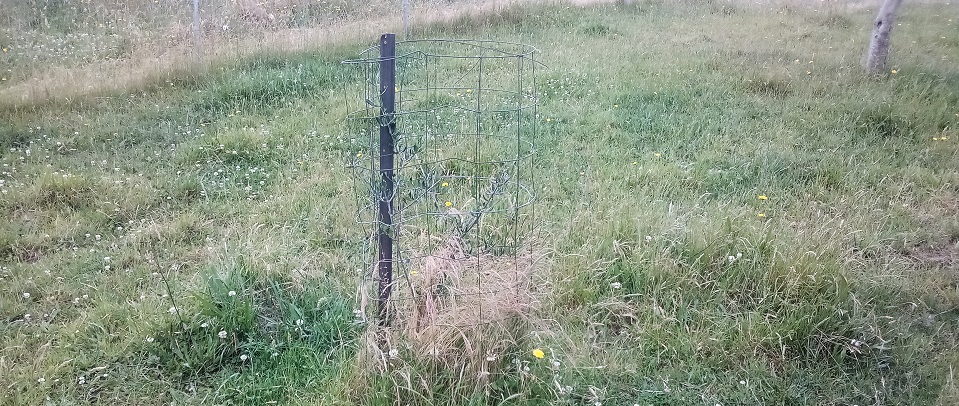
Rudimentrary tree guard for olive sapling in olive grove... chicken mesh and ringlock/sheepmesh. Main issue is browsing cattle, but this seems to be enough to protect the tree. So far we haven't had any on these guarded saplings damaged by cattle. Interestingly, if we do the same thing just in chicken wire the cattle will rub against it to scratch, and damage the guard.
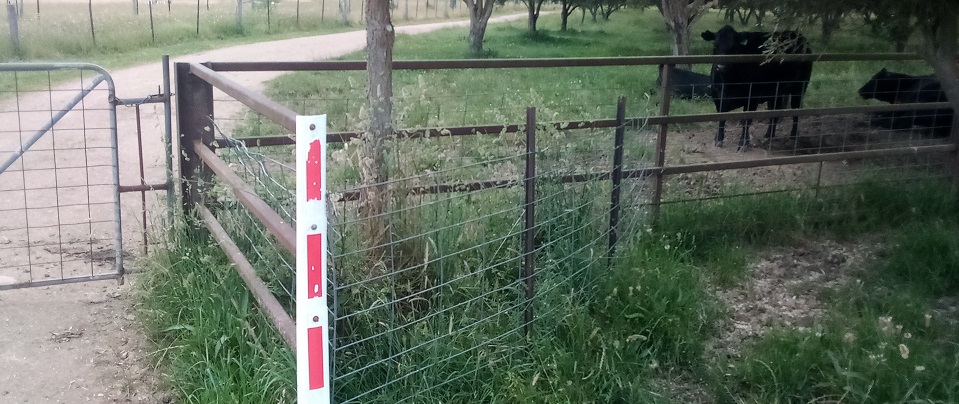
Heavy duty tree guard. Two sides are heavy welded steel, the third side is a heavy gauge sheep mesh panel. The centre of the triangle was out of reach of the cows. The tree (pine nut) sustained some damage as it grew higher and spread, but wasn't really to the cows taste. Its now high enough that I will be able to remove the mesh side soon.
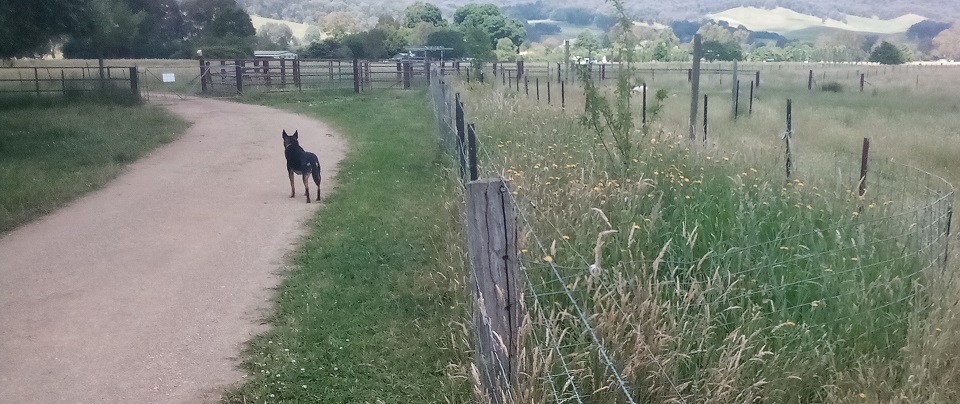
Semi-successful laneway planting. This was set up parallel to our main driveway to provide a shaded drive. The laneway is in the sheep paddock area, and the 90cm light huage sheep mesh fixed to star pickets has been adequate to protect the trees, and low enough I can step over to occasionally weed. Unfortunately fails when we put the cattle in this paddock ( once a year, during harvest). This steer jumped the 90 cm to get into the laneway and smash it all up. As you do....
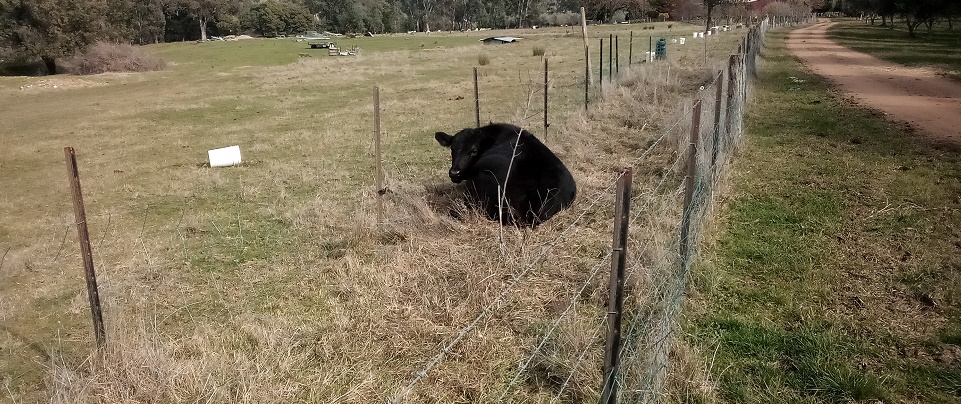
.
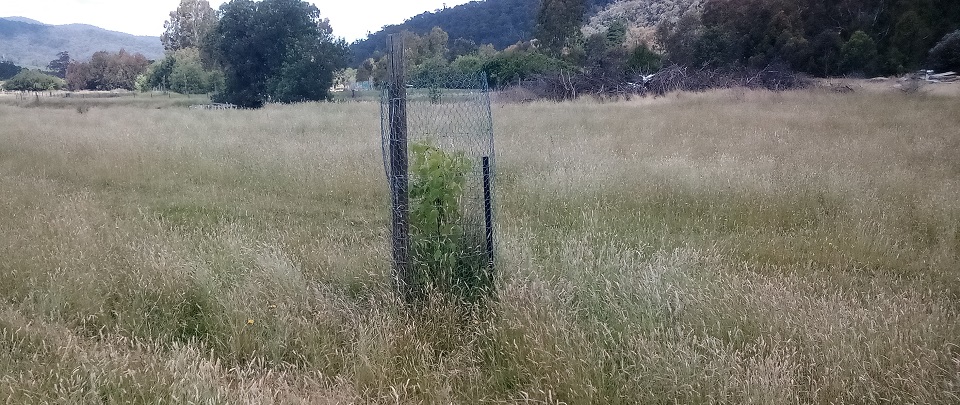
Heavy-duty longterm guards for sheep paddock. These are 1.5 metre high, wrapped around a sunk/rammed pine post and two star pickets....its not going anywhere! There are two layers of wire...sheep mesh/ringlock for strength, and chicken wire to prevent the sheep from getting their heads inside the cage. Trees are 18 months old, with 80% surviving. Weeds inside the cage are an issue, and being easily able to unwrap for weeding would be useful.
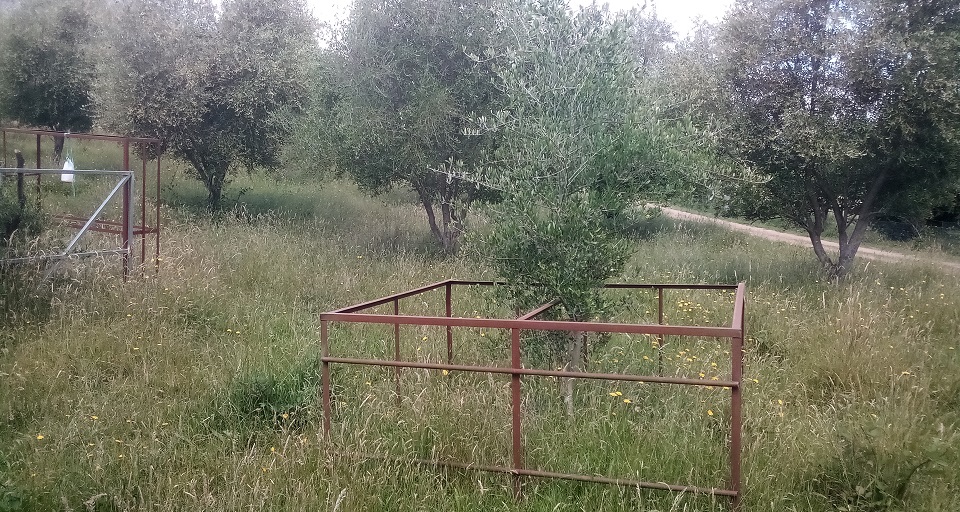
These are for keeping cattle off. They are steel frames that come inside shipping containers, used as a forkable wardrobe for transporting clothing. Allows the suits to be packed and ready for transport, and loaded in minutes. For awhile we had access to these free and collected quite a few. As tree guards they have no wire, its just the edged metal that keeps the cattle at a distance. Great solution and re-usable over time. Slow though....in seven years I have moved one onto a new sapling!
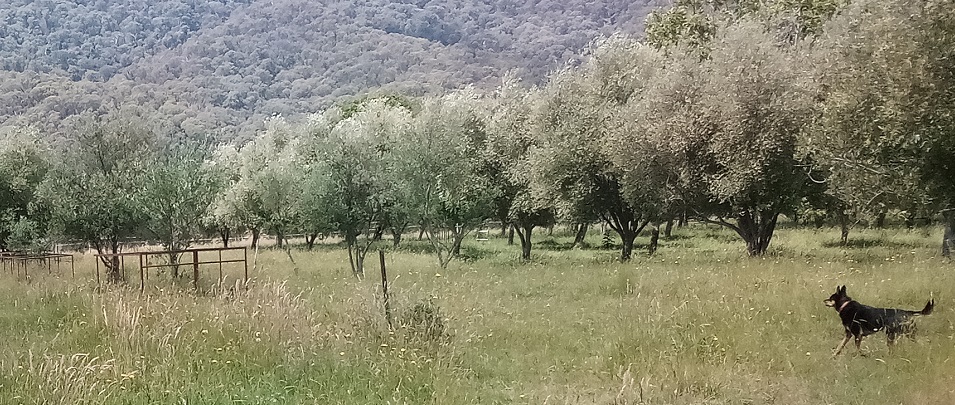
Not a great pic, but shows a couple of steel frames in place, on the left. You can see the saplings are quite big still. If the cows get access to these small trees they can rip down enough branches to kill the tree, so the frame will be needed for a couple more years. (By then the tree will be quite big and I will probably have to cut the frame off and reweld it back together. If I was smart I would make it a re-useable join.....)
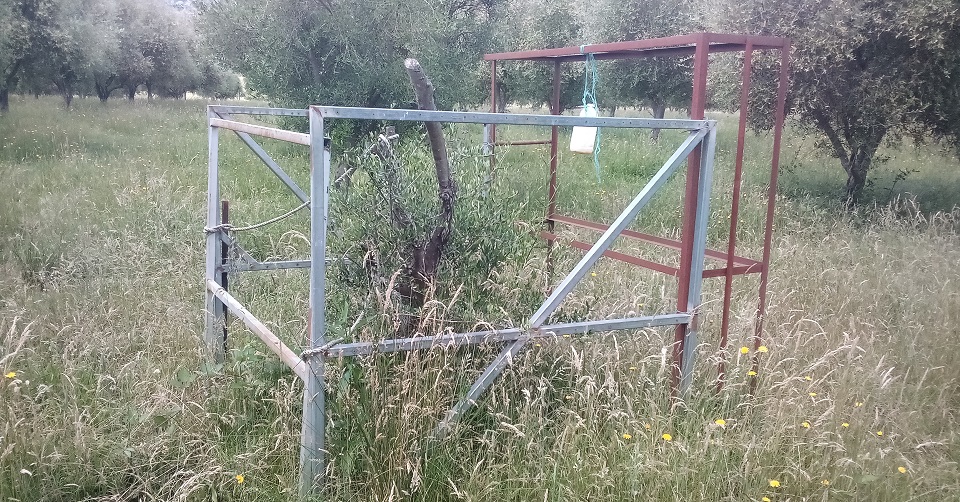
Five years ago the harvest contractors backed over this mature olive tree in a semi-trailer and pulled it out of the ground. Just to be sure they went forward and backed again, then drove off. We got it back into the ground and assembled this heavy duty frame to stop the cows punishing the tree as it tried to recover. The whole exercise is pretty pointless. As you can see the tree has not recovered. Its covered in short bursts of new growth, but nothing has grown into a branch. Given harvesting is via a mechanical tree-shaker, this tree will never be harvested again anyway. On the positive side, the tree guard has worked well!
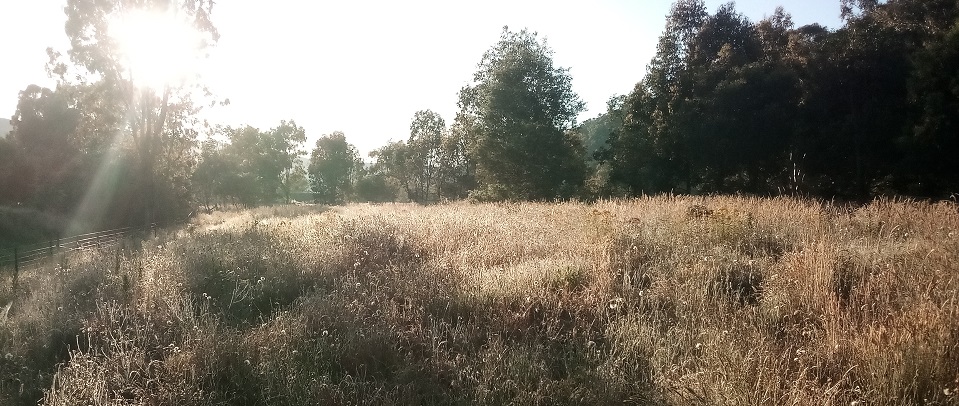
This is a variation of the laneway planting...except its a whole paddock! Rather than muck around with individual treeguards the whole paddock has been locked off.
When we moved in this was called the Stone Paddock. The entire thing was mining spoil, almost no soil just riverstones. Over summer it baked dry. We followed the lead of the previous owner and planted out gums and other natives. For a few years everything died, but we now have a working system and most of our plantings in the last two years are taking. Its not a great photo but a few small saplings are just visibly sticking their heads above the grass. Eventually we will graze sheep in this paddock, but the trees will have to be big enough. Might not be in mu lifetime....!
